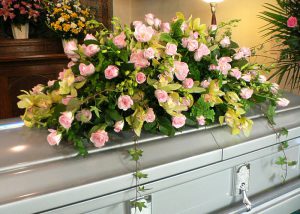Doctor at the Funeral
 by Danielle Ofri
by Danielle Ofri
New York Times
Death is a given in medicine. That truism, though, doesn’t offer much comfort when it’s your patient who has died. I was in clinic the other day, showing the ropes to a fresh-faced medical student, when a nurse leaned toward me and whispered that L.W. had died over the holiday weekend.
It was like a sucker-punch in the gut, the raw rope of grief lashing out unexpectedly. L.W. had been an employee of our hospital for 30 years. Two years ago, when we were working together on the cardiac ward, she asked me shyly if I could be her doctor. “I haven’t had a checkup in years,” she confessed, “but I’m planning to retire next year when I turn 55, so I should probably do one now.”
L.W. was a healthy, energetic woman, coming to me for a routine visit. The path to colon cancer was jarringly swift and wholly unexpected. And now her death — in the midst of treatment for the cancer — was even more unexpected. An autopsy was not done, so I couldn’t know if her death was directly from the cancer, from one of the complications of cancer, from one of the complications of treatments for cancer, or from some other random horrible event.
But knowing the immediate cause of death wouldn’t change much. Reason would do little to loosen the coarse knot in my gut as I slouched in the hard plastic seat on the way to the funeral, the train snaking into a distant neighborhood far from my hospital. Etiologies and pathophysiology satisfy only one part of medicine. They don’t edge into the other side.
When I work in the hospital wards, death is a more constant presence. Patients are, by definition, far sicker than those I see in the clinic. Sudden torrents of pathology are common — cardiac arrest, septic shock, respiratory failure. Often these are patients I’ve known only for the few days since their admission. Death is painful, but feels a bit more distant.
But in the clinic, relationships between doctor and patient often last years. They can be tightly knit, and heavily nuanced, a rooted connection that feels like family.
And so it was with L.W. Two years can be a long time, especially when unexpectedly journeying together from good health to grave illness.
Attending funerals holds an unusual place in medicine. On the one hand, a funeral can be an intensely private family experience, uncomfortable for those who are not part of the deceased’s immediate circle. On the other hand, the funeral can be the sunset point in the arc of a doctor-patient relationship.
The little research that has been done suggests that most families appreciate the presence of the loved one’s physician. In my own experience, families are quite surprised, but usually honored, to see the doctor in attendance. I’ve been proudly introduced to more aunts, uncles and cousins than I can possibly keep track of. But after the introductions, there’s always an uncomfortable gap in the proceedings, as if they don’t quite know what to do with me.
I feel like a respected guest, but one who causes others to stiffen slightly with formality. I’m careful not to overstay my welcome.
Many doctors express a desire to attend their patients’ funerals. But it can be nigh impossible to reschedule 20 patient appointments or rearrange a planned operation on the short notice that funerals typically offer. And beyond the logistical scheduling challenges lies an inner core of ambivalence; now that the medical care chapter has closed, we’re not quite sure how we fit into the patient’s life. We were so recently actively directing the medical care — doing something — and now we are the awkward bystanders, often abashed by the deference paid by families.
But the deeper truth, I think, is that it’s just too painful. Not because we feel that the death of a patient is a “failure,” as stereotype often has it. But because it hurts to keep losing members of the family. It hurts to keep seeing the bodies of your patients — bodies with whom you have been intimately familiar — laid out in stone-cold carriage. It hurts to see the face of someone with whom you’ve had deeply personal conversation, now rigid with that oddly blank expression. It just hurts.
It never gets easy. Not even after years in practice.
Now the train has unshackled itself from the underground tunnels of the city to the elevated tracks, revealing an appropriately dreary, rain-soaked day. I am perversely glad for this endlessly plodding train. It hasn’t yet been 24 hours since I learned of L.W.’s death, and I feel muddled and restless.
Part of me is dreading the arrival at my destination, dreading the acknowledgment of her death. But part of me is anxious to see her, to touch her hand one last time, to remember that we were connected in the peculiar hybrid of the professional and the personal that is the doctor-patient relationship.
The rain pounds against the subway windows, rattling like pellets of grief. The subway car heaves and groans like a reluctant ferryman, lumbering to a stop, then lurching forward again.
“East 225th Street,” an automated voice announces, and I stumble to my feet. The doors part and I step out onto the platform, immediately drenched by the driving rain. (From the New York Times)
